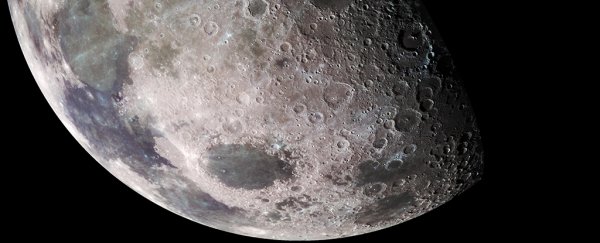The most popular hypothesis for how our Moon came to be is the giant impact hypothesis: the idea that a Mars-sized planet smashed into Earth about 4.5 billion years ago, throwing breakaway chunks of crust into space that eventually bonded to form the Moon.
There's good evidence to back up that idea, but now scientists have developed an alternative hypothesis - one that suggests that Earth and the Moon both formed from the same molten material.
The new model, put forward by researchers from the University of California, Davis, helps to explain why Earth and the Moon have a largely similar chemical composition.
It suggests that the original 'giant impact' collision was much larger than previously thought, destroying most of the early Earth and Theia - the hypothesised planet that smashed into it.
Much of the material that got blasted away from Earth would have likely fallen back as the planet cooled.
So while a violent planetary smash still happened, the Moon isn't the remnant of something that hit Earth and spun away, but a chunk of the same material Earth was formed out of, the scientists suggest.
"One giant impact sets off the sequence of events," explained lead researcher Sarah Stewart.
The new study builds on previous research by Stewart and colleague Matija Ćuk, which proposed that some of the momentum caused by the pull between early Earth and the Moon affected the movement between Earth and the Sun.
Those calculations matter, because they allow for a larger impact collision in the beginning.
Now Stewart, Ćuk, and colleagues from the University of Maryland and Harvard University have taken that idea even further, suggesting that the original giant impact created a huge mass of molten - vaporised matter that both Earth and the Moon then formed from.
The hypothesis suggests that tidal forces reduced the momentum sparked by Earth and the Moon's close relationship, until planet and moon reached the so-called Laplace plane transition point - the point at which the Sun's pull became more significant than the Moon's.
 The new model suggests a more abrupt transition in oscillations could help explain the Moon's current tilt. Credit: Douglas Hamilton
The new model suggests a more abrupt transition in oscillations could help explain the Moon's current tilt. Credit: Douglas Hamilton
The team's new models show the Moon orbiting Earth at a high inclination at this point - the angle between the Moon's orbit and Earth's equator. They also show Earth spinning very fast, giving it a 2 or 3-hour day.
After tens of millions of years, gravitational forces caused this spin to slow, and eventually a second transition point happened - a Cassini state transition - where the Moon shifted to its current 5-degree inclination.
To put it simply, the scientists suggest that the Sun helped shift Earth to its current 23-degree tilt, which in turn helped shift the Moon to its 5-degree incline.
The researchers say this inclination is another piece of the puzzle that fits better with the new hypothesis that the widely accepted giant impact model. They plan to test various parts of their hypothesis in the coming months, particularly in terms of the chemical composition of Earth and the Moon.
"What's beautiful about this work is that we can end up with the current state of the Moon - its orbit, its chemistry - with just one step, without invoking any other event," Stewart told Charles Choi at Space.com.
"We don't invoke a sequence of events that needs to be just right to explain the Moon's current state."
The research has been published in Nature.
